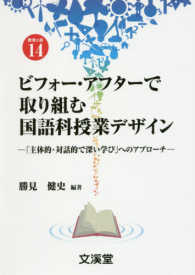- ホーム
- > 洋書
- > 英文書
- > Nature / Ecology
Full Description
A one stop, comprehensive textbook, covering the three essential components of air pollution science. The Third Edition has been updated with the latest developments, especially the inclusion of new information on the role of air pollutants in climate change. The authors give greater coverage to the developing economies around the world where air pollution problems are on the rise. The Third Edition continues to cover a wide range of air quality issues, retaining a quantitative perspective. Topics covered include - gaseous and particulate air pollutants, measurement techniques, meteorology and dispersion modelling, mobile sources, indoor air, effects on plants, materials, humans and animals. Moving away from classical toxic air pollutants, there is a chapter on climate change and another on the depletion of stratospheric ozone. A special feature of this new edition is the inclusion of a fresh chapter on air pollution mitigation by vegetation, mainly its role in maintaining a sustainable urban environment. Recommended for upper-level undergraduate and postgraduate courses specialising in air pollution, both for environmental scientists and engineers. The new material included in the Third Edition extends its use by practitioners in consultancies or local authorities.
Contents
Air PollutantsUnits for Expressing Pollutant ConcentrationThe Basic AtmosphereThe Vertical Structure of the AtmosphereAnthropogenic EmissionsPrimary Emission SummaryAdsorption and Adsorption of GasesOther Air PollutantsSecondary Gaseous PollutantsEmission InterventionsAir Pollutants: ParticulatesParticle TerminologyParticle Size DisturbationsAerosol MechanicsParticle SourcesAbatement of Primary Particle EmissionsSecondary ParticlesTrends in Particle EmissionsMobile SourcesMotor Vehicle EmissionsTrain EmissionsShipping EmissionsAircraft EmissionsDifferent Models of TransportMeasurement of Gases and ParticlesMethods of Describing Pollutant ConcentrationSampling RequirementsGas SamplingGas Concentration MeasurementQuality ControlParticle SamplingParticle Measurement MethodsChemical Composition of AerosolMeasurement of Course Particle DepositionEmission Measurement from Stationary SourcesMeasurement UncertaintyConcentrations and DepositionGaseous PollutantsPatterns of OccurrenceParticulate MatterDry Deposition of GasesWet DepositionTotal Deposition and BudgetsAnalysis of an Air Pollution EpisodeMeteorology and ModellingMeteorological FactorsDispersion ModelsGaussian Dispersion TheoryDispersion Theory in PracticeDispersion of Vehicle Emission and Exposure ModellingReceptor ModelsBox ModelsStatistical ModelsAnalysis of an Air Quality Data SetThe Raw Data SetPeriod AveragesRosesDiurnal VariationsShort-Term EventsFrequency DisturbationsFurther Statistical AnalysesIndoor Air QualityBuilding VentilationCombustionIndoor Organics SourcesBioaerosolsSick Building SyndromeOdour and VentilationClean RoomsMitigation of Air Pollution: The Role of VegetationForest Canopy InterventionParticle Deposition to VegetationFilter StripsPractical Concerns of Vegetation InterventionEffects on Plants, Visual Range and MaterialsEffects on PlantsVisual RangeDamage to MaterialsResponses of Humans and Other AnimalsResponses of PeopleEffects on Other AnimalsGreenhouse Gases and Climate ChangeOur Radiation EnvironmentThe Role of GasesThe Role of AerosolGases and Aerosol CombinedFuture ScenariosThe Main PredictionsFeedbacksGlobal ResponsesOzone Depletion and Ultraviolet RadiationOzone in the StratosphereDestructive ChemistryThe Current SituationOzone and UltravioletClothing Protection from UVStandards and LegislationUK LegislationEU Air-Quality LegislationUNECEWorld Health Organization (WHO)EU Industrial Emission LegislationEU Vehicle EmissionsUS LegislationLegislation in the Asian RegionAir Pollution Indices







